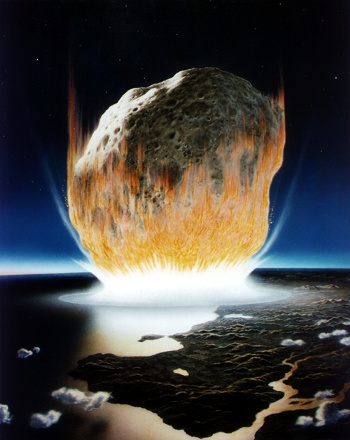The Late Heavy Bombardment
April 13, 2011
The
Late Heavy Bombardment sounds like the second wave of television shows that's launched in the middle of a current season to replace some other bombs that only made it through a few episodes.
The Late Heavy Bombardment (LHB) is actually the name given to the process that caused many large
impact craters on the
Moon about four billion years ago. There's no apparent reason why this happened, although it's suspected to be the result of shifting orbits of objects in the
asteroid belt as the
solar system established itself in its present, mostly stable, condition.
Since these objects hit the Moon, some must have hit the
Earth, also. A simple
extrapolation of the crater size distribution and areal density on the Moon leads to an Earth scenario of at least 20,000 planet-scarring impacts, a few that would result in craters of 5,000 km diameter, and about forty craters of thousand kilometer diameter. Impacts would occur at intervals of about a hundred years.[1]
Life on Earth is thought to have arisen at about the same time. It's interesting to speculate whether life had several false starts, only to be extinguished by an LHB object.

There goes the neighborhood!
Artist's impression of a huge meteor impact on Earth.
NASA Image (Don Davis)
Although large impacts dominated the first part of the LHB, recent research indicates that the tail end of the LHB might have further delayed the
abiogensis of life on Earth. I wrote about abiogensis in a
previous article (Catalytic Abiogenesis, January 26, 2011). Two
planetary geologists from
Imperial College London have published a paper in
Geochimica et Cosmochimica Acta that provides evidence that the infall of less catastrophic meteoric material may have been responsible for cooling the Earth to temperatures too low to support life.[2-3] Surprisingly, this is an
experimental paper.
The author's motivation was the fact that micrometeorites are responsible for about a 2400
ton influx of
sulfur dioxide into Earth's atmosphere annually. The geologists used
Fourier-transform infrared spectroscopy (FTIR) to analyze the sulfur dioxide produced by
flash pyrolysis of specimens of composition similar to five representative meteorites. These are
Orgueil (CI1), ALH 88045 (CM1), Cold Bokkeveld (CM2),
Murchison (CM2) and Mokoia (CV3), all
carbonaceous chondrites. The flash pyrolysis simulated the infall condition of the micrometeorites, which heat to about 1000 °C.
The authors conclude that the LHB would have pumped about 20 megatons of sulfur dioxide annually into Earth's atmosphere.
Sulphate aerosols high in Earth's atmosphere would have scattered sunlight, reducing
insolation at the surface, thereby cooling it. This cooling process would have delayed the genesis of life on Earth, and it might have prevented the genesis of life on
Mars. At the time of the LHB, the Sun's energy output was about 30% less than it is today, so an additional cooling could have put the entire Earth into an
Arctic winter for millions of years.
If micrometeorites are responsible for thousands of tons of just sulfur dioxide annually on Earth, are there other remnants of these? As it turns out, there are so many that you can harvest micrometeorites from your own backyard.[4-5] Estimates are that about 30,000 tons of material are deposited annually on Earth from outer space. Some of this just vaporizes, but quite a lot of microscopic solid matter reaches the ground.
The surface area of the Earth is about 5 x 10
8 square kilometers. The land area on which my home sits is a third
acre, or 0.00134 square kilometer. If we assume that 11,000 tons (10
10 grams) of meteoritic matter reaches the Earth's surface each year, then the amount landing annually on my little third acre is
1010 x 1.34 x 10-3 / 5 x 108 = 0.0268 grams = 26.8 mg
Not a considerable quantity, but still detectable by the following method.[4-5] During a rainstorm, collect your downspout water in a large container. This water will contain most of the material that settled on your roof since the last rainstorm. After the storm, decant most of the water, leaving the solid residue at the bottom of the container. After removing the larger, obviously non-meteoric, objects, sift the remainder with a powerful
rare earth magnet.[6] Since many meteorites contain
iron and
nickel, they will be attracted to the magnet.
You'll need a
microscope to select the real meteorites from terrestrial
minerals. Airborne ferrous mineral particles will have a rough shape, whereas the meteorites will be generally spherical and glassy. Read much more about this at Ref. 5.
By the way, the geologists at the Imperial College London write
sulphur, not
sulfur. For an analysis of the sulphur
vs sulfur controversy, read my
previous article, Van Gogh Versus the Sulfates, March 1, 2011.
References:
- Late Heavy Bombardment page on Wikipedia.
- Richard W. Court and Mark A. Sephtona, "The contribution of sulphur dioxide from ablating micrometeorites to the atmospheres of Earth and Mars," Geochimica et Cosmochimica Acta, vol. 75, no. 7 (April 1, 2011), pp. 1704-1717.
- Colin Smith, "Sugar-grain sized meteorites rocked the climates of early Earth and Mars, according to new study," Imperial College London News Release, April 1, 2011
- Steve Spangler, "A Meteorite Hit My House! How to Use a Neodymium Magnet to Find a Micrometeorite, " October 21, 2004.
- Robert Beauford, "How do I find micrometeorites?" (No date).
- You can salvage these from the head arm actuators of old hard disk drives. Information on this process is available on the internet. One caution is that these magnets can cause injury, so read about that, also.
Permanent Link to this article
Linked Keywords: Late Heavy Bombardment; impact crater; Moon; asteroid belt; solar system; Earth; extrapolation; origin of life on Earth; NASA; Don Davis; planetary geologists; Imperial College London; Geochimica et Cosmochimica Acta; experimental; ton; sulfur dioxide; Fourier-transform infrared spectroscopy; FTIR; flash pyrolysis; Orgueil (CI1); Murchison (CM2); carbonaceous chondrite; sulphate aerosols; insolation; Mars; Arctic winter; square kilometer; acre; rare earth magnet; iron; nickel; microscope; mineral.